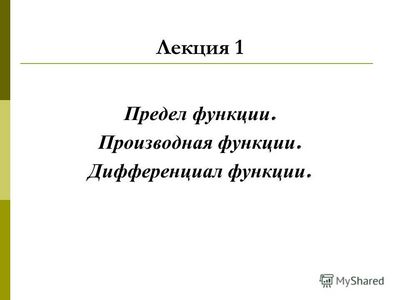
1. Limit of the sequence
Denition 1
A sequence can be thought of as a list of numbers written in a
denite order y1 , y2 , . . . yn, . . .
Denition 2
The number y1 is called the rst term, y2 is the second term,
and in general yn is the nth term.
A sequence can also be dened as a function whose domain is the
set of all positive integers. We usually write yn (or xn) instead of the
function notation for the (real) value at n.
N o t a t i o n 1
The sequence {y1, y2, . . .} is also denoted by {yn} or {yn}n=1 .
Denition 3
A sequence {xn} is called increasing if xn+1 > xn for all n
1,
that is x1 < x2 < . . . < xn < . . .. It is called decreasing if xn+1 < xn
for all n.
Denition 4
Non-increasing means xn+1
Denition 5
xn , non-decreasing : xn+1
xn.
A sequence xn is called monotonic if it is either non-decreasing
or non-increasing. It is called strictly monotonic if it is either decreasing
or increasing.
Denition 6
A sequence {xn} is called bounded if there is such a number M
that |xn | < M for all n 1.
E x a m p l e 1
xn= 1/n is decreasing. xn=
1 + (1)n
2
is bounded since |xn| <
2. The sequence xn=n is unbounded.
If we let xn be the digit in the nth decimal place of the number
e, the Euler number (to be dened later in the text), then xn is a
well-dened sequence but it doesn’t have a simple dening equation.
Denition 7
Fibonacci sequence xn is dened recursively by the conditions
x1 = 1, x2 = 1, xn = xn1 + xn2,
n
3.
Each term is the sum of the two preceding terms:
{1, 1, 2, 3, 5, 8, 13 . . .}
This sequence arose when the 13th-century Italian mathematician
Fibonacci solved a problem concerning the breeding of rabbits.
n
Consider the sequence
n + 1
. It appears that its terms are approaching
1 as n becomes large. In fact, the dierence
1 xn= 1n=
1
n + 1
n + 1
can be made as small as we like by taking n suciently large. Let
n
us indicate this by writing lim
n> n + 1
= 1.
In general, the notation lim
n>
= L means that the terms of the
sequence xn approach L as n becomes large.
Denition 8
A sequence {xn} has the limit L and we write lim
n>
xn= L or
xn > L as n > if we can make the terms xn as close to L as
we like by taking n suciently large. Ifnlim xnexists, we say the
>
sequence converges (or is convergent ). Otherwise, we say it diverges
(or is divergent ).
To make the above even more precise: L is the limit of xn, if for
an arbitrary positive there exists such N (which might depend on
) that |xn L| < as soon as n
N .
1.1.
Limit Laws for Convergent Sequences
If {an} and {bn} are convergent sequences and c is a constant,
then
lim (an+bn) = lim
an+ lim bn;
n>
n>
n>
lim (an bn) = lim
annlim
bn;
n>
lim
n>
n>
c • an=c lim
n>
an;
>
lim (anbn) = lim
an• lim
bn;
n>
lim
an
=
n>
lim
n>
an
,
n>
if
lim
bn= 0,
n> bn
lim bn
n>
n>
lim
n>
c = c.
Let us now consider a few situations which involve unbounded
sequences.
E x a m p l e 2
v
v
1) xn= 1/
n, yn=n,
xn • yn=
n > ;
2) xn=a/n, yn=n,
3) xn= 1/n2, yn=n,
xn • yn=a > a;
xn • yn= 1/n > 0;
4) xn= (1)n/n, yn=n,
xn • yn= (1)n, no limit.
In each case, we were in a 0 • indeterminate situation.
A few technicalities (when working with sequences).
n2 + 1
Let xn=
n2 1
. When trying to apply the respective limit law,
we get an indeterminate expression. A way to go is to divide both
5
the top and the bottom by n2:
1 + 1/n2
xn=1 1/n2=
1 1
where an = 1 + ,bn= 1 .
a
n
bn
,
n2
n2
Now, the limit law is applicable. We conclude that lim xn= 1.
n>
Later, when discussing the limit of a function, we will state a
theorem which deals with a limit of a rational function (that is, the
quotient of two polynomials).
v
v
v
Consider one other example. Let xn=
n(
n + 1
n). Again,
the limit law is inapplicable, we are in • 0 situation. A key word
here is “conjugate” (to try to get rid of one radical, at least). We
multiply xn by
1 =
vvn+ 1 + vvn
n + 1 + n
to get a new expression for the nth term:
vn
xn=vn+ 1 + vn,
still indeterminate expression.
We now do something similar to the previous example: we divide
both the numerator and the denominator by
v
n to get an expression
where we conclude easily about the existence of the limit:
1
1
xn=1 + 1/n + 1 >n> v1 + 0 + 1=12.
Denition 9
A sequence xn is bounded above if there is a number M such
that xn < M for all n
1.
It is bounded below if there is a number M such that xn > M for
all n
1.
6
(As we have dened earlier, if it is bounded above and below,
then xn is called a bounded sequence.)
Theorem
